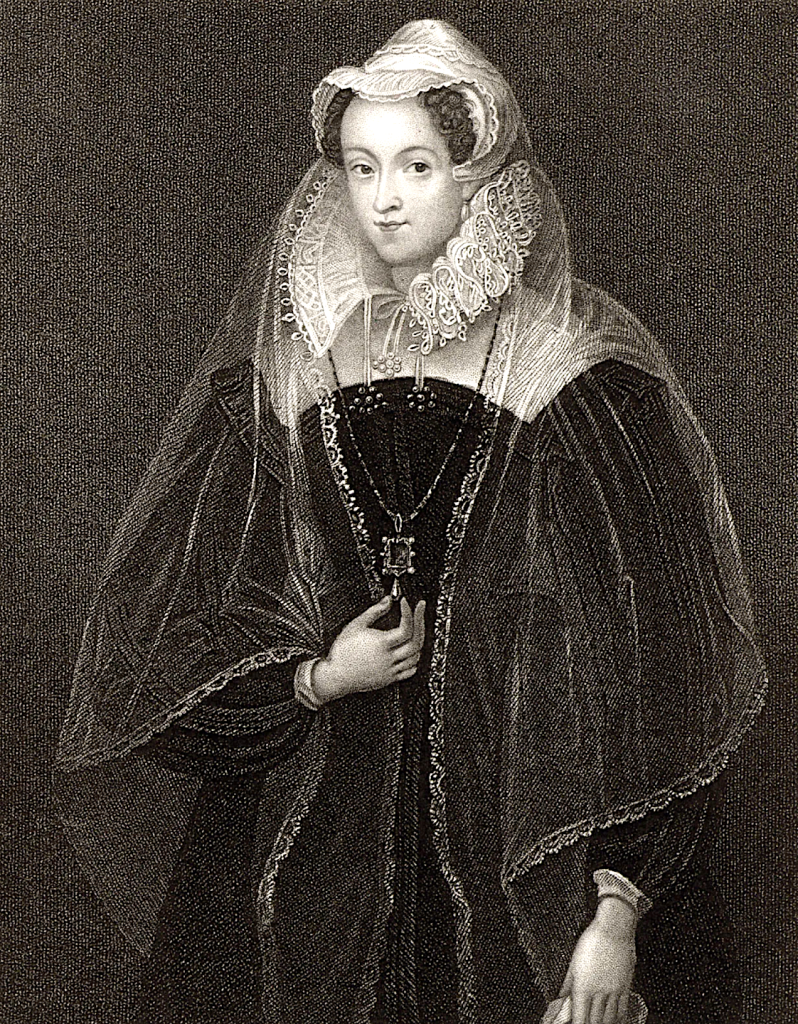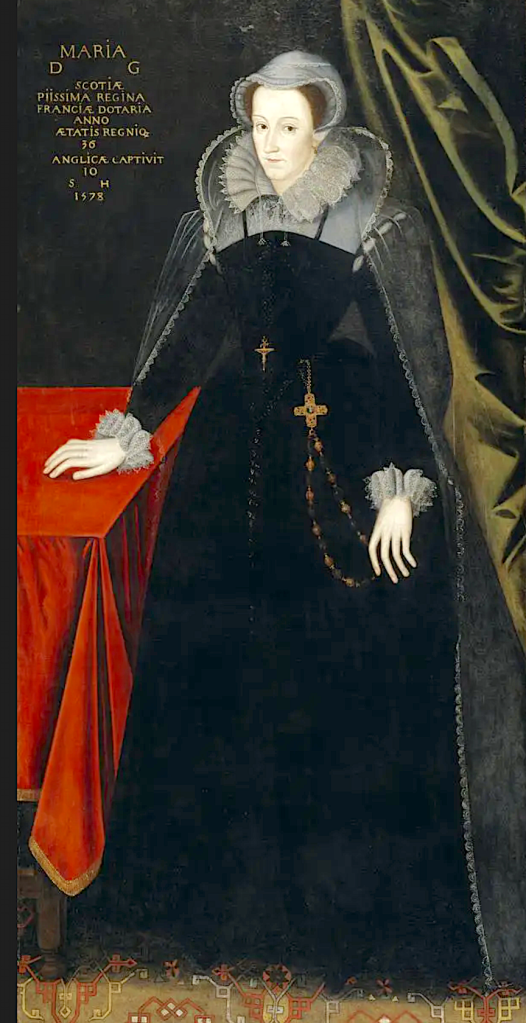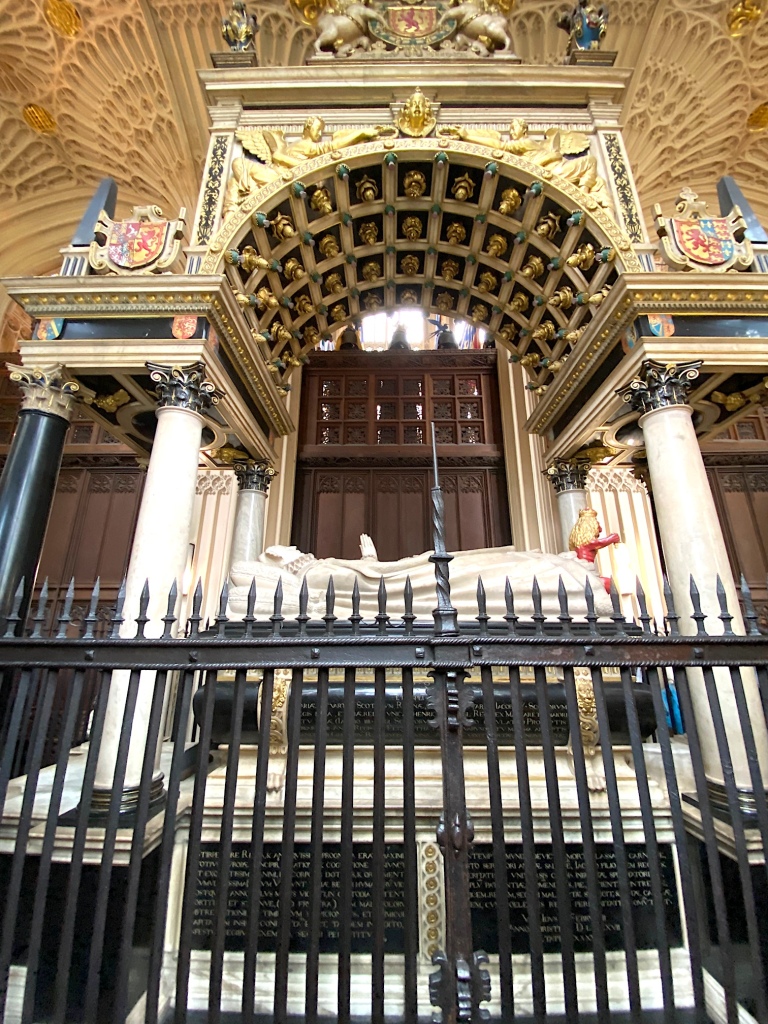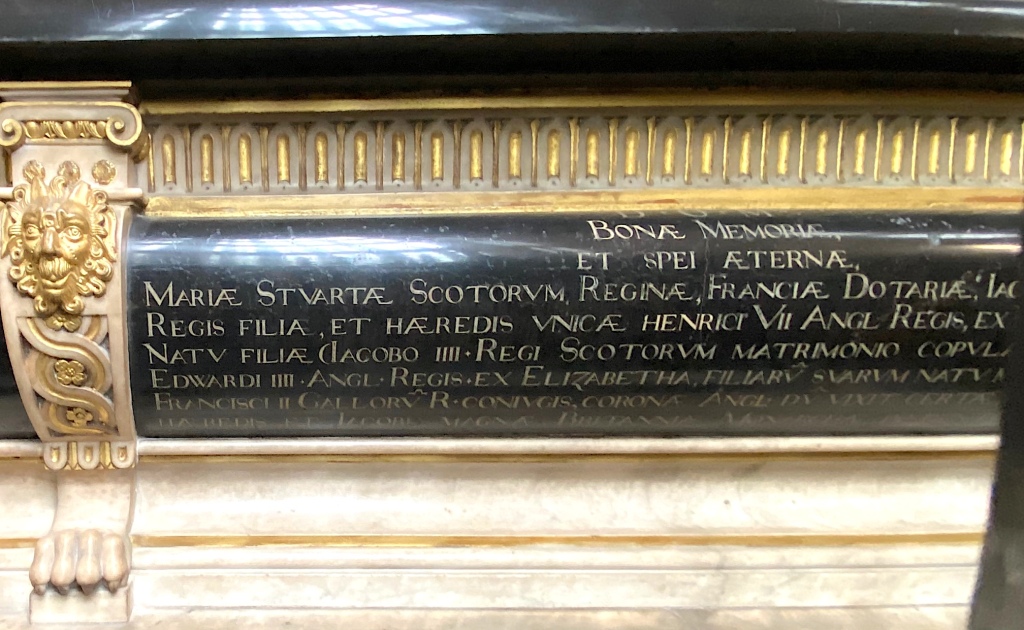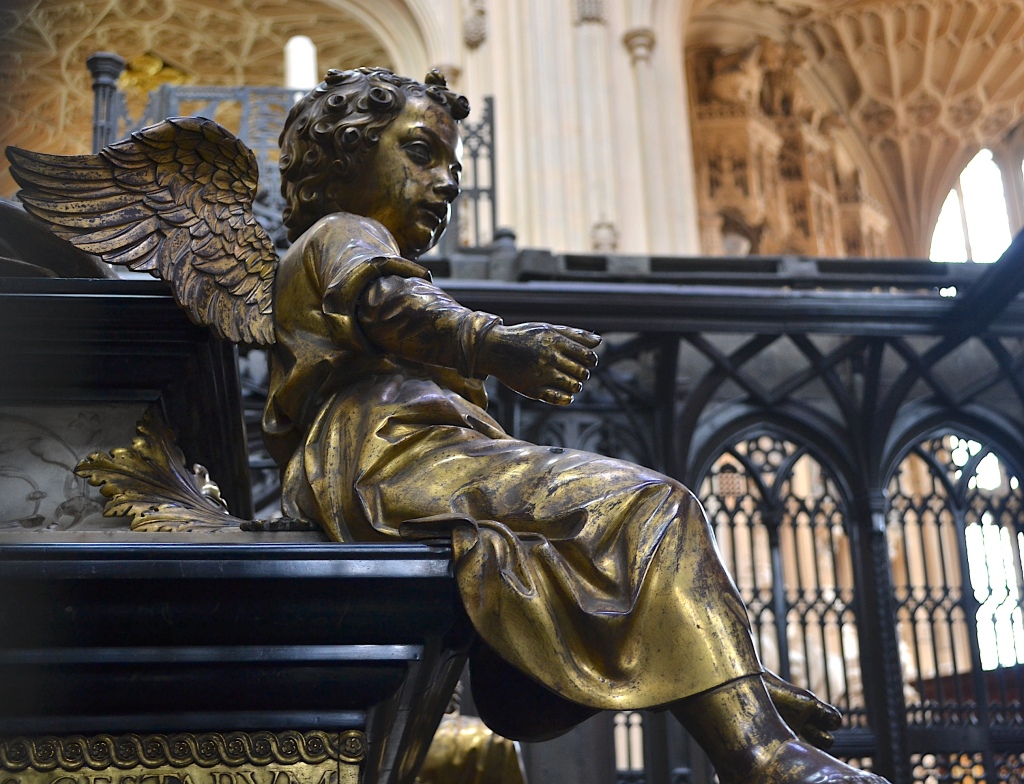This week, I’m going to tackle the story (and tomb) of Mary, Queen of Scots. That’s rather a tall order because her history is tragic and her monument/grave is even grander than that of her cousin, Queen Elizabeth I (whom I talked about a few weeks ago).
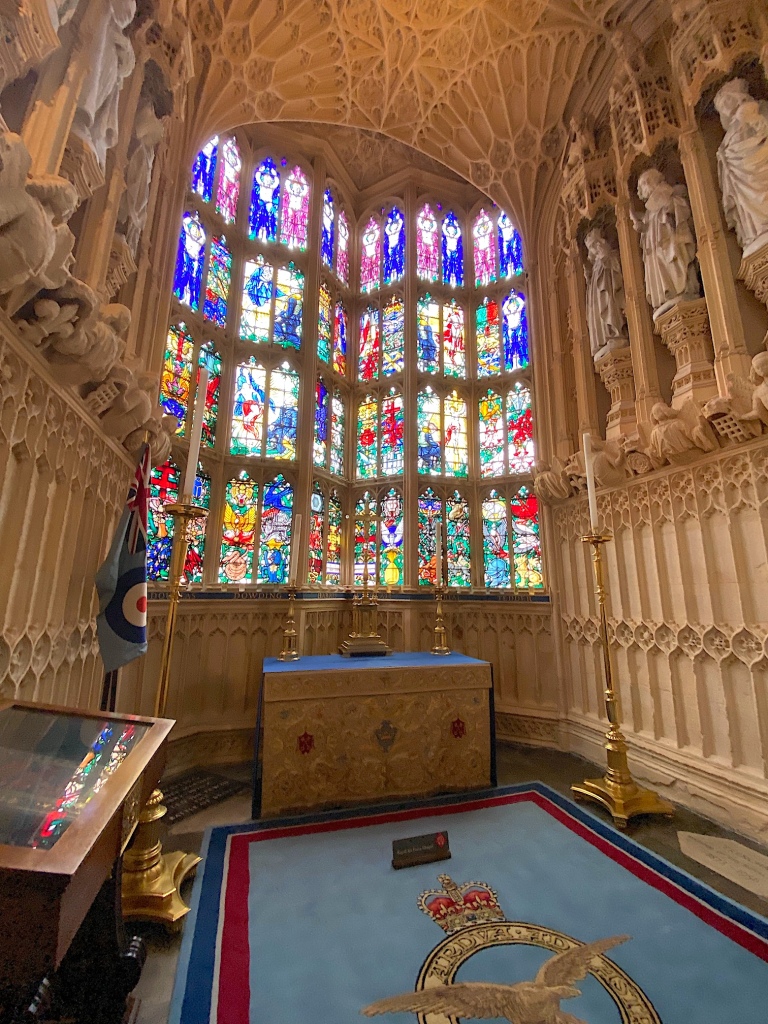
First, let’s talk about Mary and how she fits into the complex history of the British/Scottish monarchy.
Royal Heir
Mary, Queen of Scots, was born on Dec. 8, 1542 in Linlithgow Palace in Scotland. She was the daughter of King James V of Scotland and Mary of Guise. Her father died just a week after her birth.
Incidentally, Mary of Guise was first married to Louis D’Orleans, duc de Longueville in 1534, by whom she had two sons. After the duc’s death in 1537, she was sought for marriage by Henry VIII and James V. She allegedly refused Henry VIII’s proposal by saying “I fear my neck is too small.”
Enthroned as Scotland’s ruler at just six days old, Mary spent her early years at the French court, where she was raised alongside future husband Francis II. They wed in 1558 but he died within a year of his accession and Mary left France in 1560 never to return.
In November 1558, Henry VIII’s elder daughter, Mary I, was succeeded by Elizabeth I. Under the Third Succession Act, Elizabeth was recognized as her sister’s heir, and Henry VIII’s last will and testament had excluded the Stuarts from succeeding to the English throne. Yet, in the eyes of many Catholics, Elizabeth was illegitimate and Mary Stuart was the rightful queen of England. Mary’s claim to the English throne was a continual sticking point between her and Elizabeth.

Second Marriage
Mary wed a second time in 1565 to Henry, Lord Darnley, son of Margaret Stewart, Countess of Lennox. They had one son in 1566 who later became King James VI of Scotland and I of England. The marriage soured but the couple was reportedly working toward reconciliation when on the night of Feb. 9, 1567, an explosion devastated Kirk o’ Field. Darnley was found dead in the garden, apparently smothered. There were no visible marks of strangulation or violence on the body.
Between April 21 and 23, 1567, Mary visited her son at Stirling for the last time (he was only 10 months old). On her way back to Edinburgh on April 24, Mary was abducted, willingly or not, by James Hepburn (Lord Bothwell) and his men, and was taken to Dunbar Castle. On May 6, Mary and Bothwell returned to Edinburgh. On 15 May 15, at either Holyrood Palace or Holyrood Abbey, they were married according to Protestant rites. Bothwell and his first wife, Jean Gordon, had divorced 12 days previously. It was not received well since many believed Bothwell was the one who had worked to have Darnley killed.
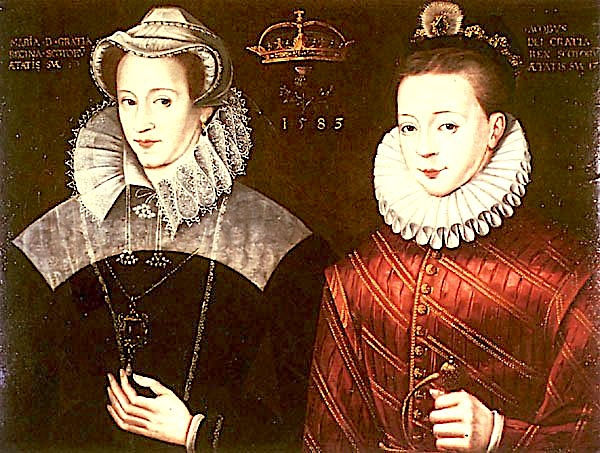
Mary and Bothwell were parted forever at Carberry Hill on June 15, 1567, Bothwell to exile and imprisonment where he died in 1578, and Mary to incarceration on the island of Loch Leven, where she was formally deposed in favor of her son James.
Imprisoned and Executed
After a brief stint of liberty the following year, defeat of her supporters at a battle at Langside put her once more to flight. Mary sought refuge in England with her cousin Elizabeth. But Elizabeth, with all the political cunning Mary lacked, used a series of excuses connected with the murder of Darnley to hold Mary in English captivity in a series of prisons for the next 18 years of her life.
It was the discovery in 1586 of a plot to assassinate Elizabeth and bring about a Roman Catholic uprising that convinced Elizabeth that, while she lived, Mary would always constitute too dangerous a threat to her own position.
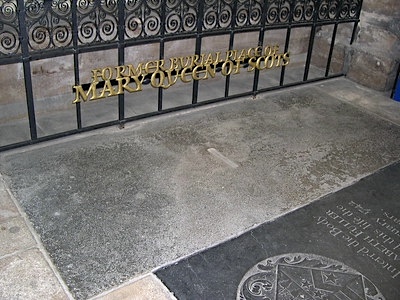
Mary was tried by an English court and condemned. James, who had not seen his mother since infancy and now had his sights fixed on succeeding to the English throne, raised no objections. Mary, now 44, was executed in 1587 in the great hall at Fotheringhay Castle, near Peterborough.
Repairing Mary’s Reputation
Mary was buried five months after her death on Aug. 5, 1587 in Peterborough Cathedral. There was already had one queen buried there, namely Katharine of Aragon, buried in 1536.
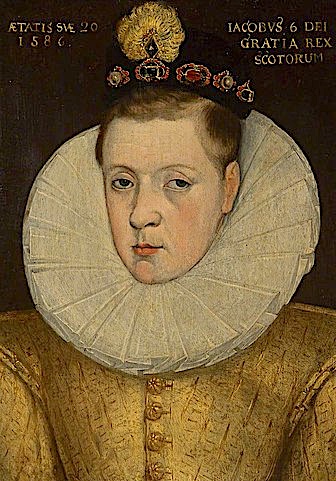
When Mary’s son, James VI, became James I of England in 1603, he did not immediately take action to move his mother. However, he did encourage rehabilitating his mother’s reputation via portraiture. A well-recognized portrait of Mary, Queen of Scots, was painted between 1610 and 1615. The portrait (see below) is held by the National Galleries of Scotland, and depicts Mary wearing a black gown and white veil; perhaps an allusion to what she wore on the day of her death.
By 1612, James had a marble tomb created for his mother in the south aisle of the Lady Chapel of Westminster Abbey. Her body was exhumed and moved from Peterborough to Westminster Abbey in October 1612. It is quite something to behold. The Scottish thistle is embedded in the arch over Mary’s effigy, I noticed.
James erected a magnificent marble tomb for his mother on which there is a fine white marble effigy under an elaborate canopy. She wears a close-fitting coif, a laced ruff, and a long mantle fastened by a brooch. The sculptors were William and Cornelius Cure. A red crowned Scottish lion stands at her feet.
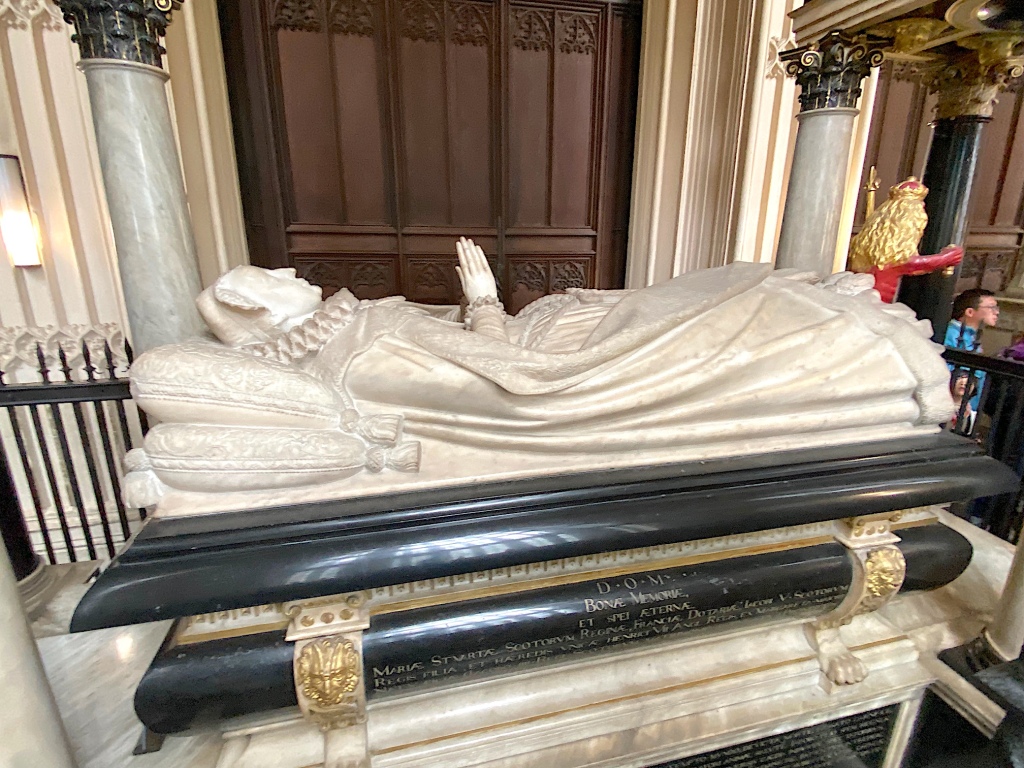
On the side of the tomb is a long inscription in Latin. Certain excerpts from the inscription show what some think is an attempt to rehabilitate Mary’s legacy:
Mistress of Scotland by law, of France by marriage, of England by expectation, thus blest, by a three-fold right, with a three-fold crown; happy, ah, only too happy, had she routed the tumult of war, and, even at a late hour, won over the neighbouring forces… here lies buried the daughter, bride and mother of kings. God grant that her sons, and all who are descended from her, may hereafter behold the cloudless days of eternity….
Perhaps by making such a statement with his mother’s tomb, James was taking further steps to redeem Mary’s public image. I do find it a bit strange that for a son who had put up no form of resistance to his mother’s execution back in 1587, he was doing quite a bit to make a show of creating such an elaborate tomb. But in looking at how things played out, I’m sure he was trying to pave the way with Elizabeth to becoming her successor when the time came.
Mary’s Mother-In-Law
I don’t know if it was by design or accident that Mary, Queen of Scots’s tomb is beside that of the mother of her second husband, Lord Darnley. Margaret Douglas’ mother was Margaret Tudor (1489-1541), daughter of Henry VII and widow of James IV of Scotland, who had married Archibald Douglas, the sixth Earl of Angus in 1514 (they divorced in 1527).
Born in 1515, the young Margaret lived for a time with her aunt Princess Mary and then became a lady-in-waiting to Anne Boleyn and led an eventful life, being imprisoned in the Tower of London on several occasions.
On July 6, 1544, she married Matthew Stewart, 13th Earl of Lennox, a descendant of James I of Scotland. Matthew died after being shot in the back in a skirmish at Stirling Castle in 1571. None of her eight children survived her and she died, in poverty, on March 19, 1578 (New Style dating).
Margaret was buried, at the expense of Elizabeth I, in the south aisle of Henry VII’s chapel in Westminster Abbey, in the same grave as her son, Charles.
The monument was completed in 1578 by her executor Thomas Fowler. The sculptor is not known. Her effigy, made of alabaster, wears a French cap and ruff with a red fur-lined cloak, over a dress of blue and gold. On either side of the tomb chest are “weepers” (small kneeling statues) of her four sons (Charles and Henry and two who died young) and four daughters (all died young).
I did unwittingly take a photo of the side where the weepers are. Darnley, Mary’s second husband, is the one with the crown over his head. He’s not actually buried there but is in the Abbey of Holyrood in Edinburgh, Scotland.
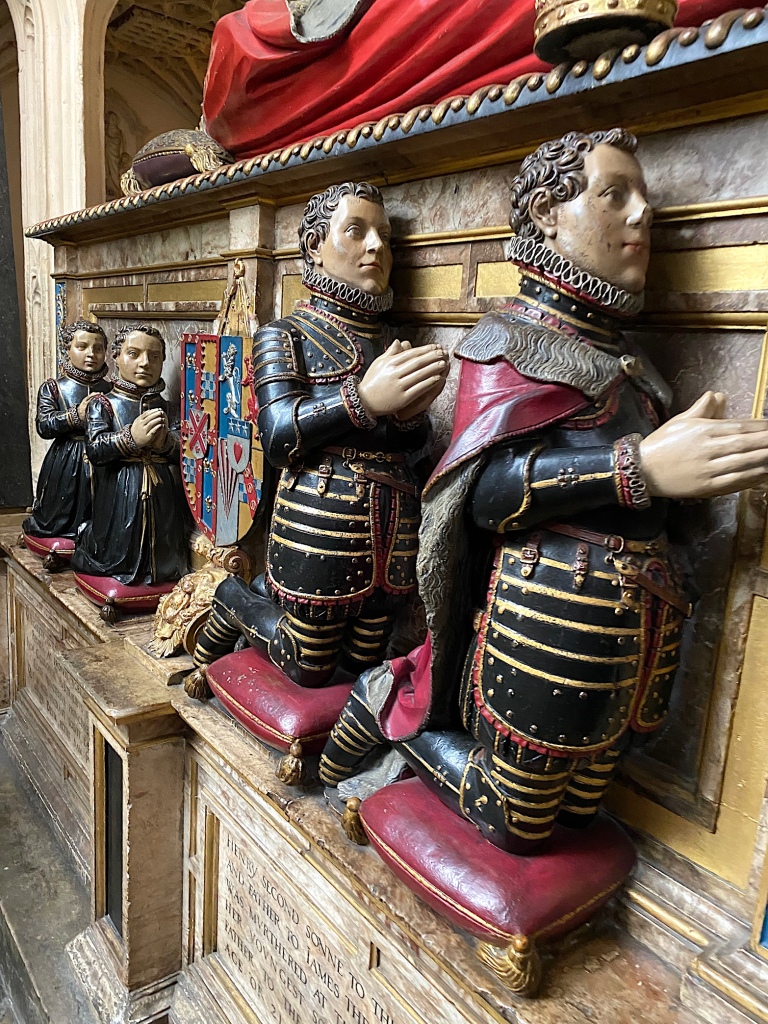
James I and Anne of Denmark
James I would eventually wed Anne of Denmark in 1589 and they had seven children together. You’ll recall the tombs of Sophia and Mary that I shared a few weeks ago that are with Queens Elizabeth and Mary. Those are two of those children. Anne died in 1619, and James I died of a stroke at age 58 in 1625.
Considering the grandness of his mother’s tomb, you might think James’s tomb would be equally grand. But that did not happen. Like Queen Mary I, he ended up being interred with someone else.

The place of his interment was rediscovered by Dean Stanley in February 1869 in the vault containing the coffins of Henry VII of England and Elizabeth of York. The body of his wife, Anne of Denmark, had been buried nearby on May 13, 1619. The antiquary John Dart saw a labelled urn containing the embalmed organs of Anne of Denmark in 1718, which he thought had been moved in 1674 during the reburial of the Princes in the Tower.
We didn’t get a very good photo of Henry VII (the king responsible for the Lady Chapel’s construction) and Elizabeth of York’s vault, sadly. There were too many people milling around it to do so. But Chris did the best he could. I did like this one he took of the angel sitting on it.
There’s so much more to see at Westminster Abbey. I’ll have more for you in Part IV.

